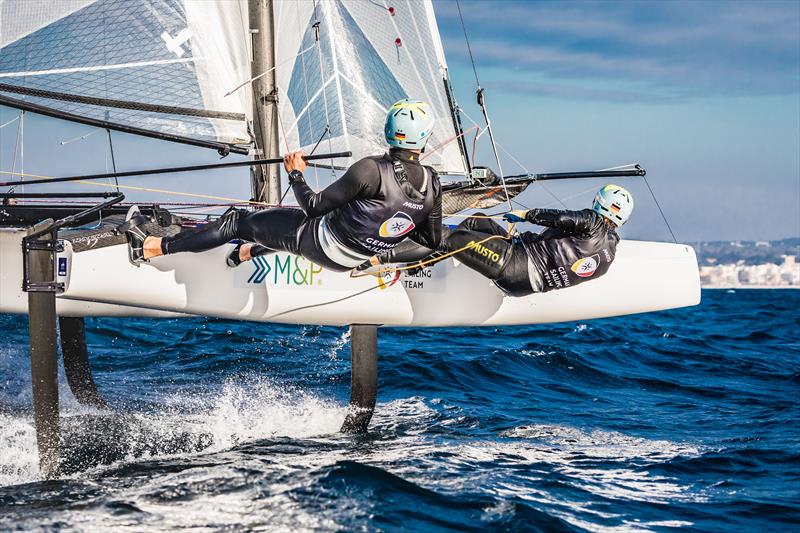
Training By The Numbers: How data is driving precision training in the Olympics and beyond
by Cyclops Marine 3 Jun 15:00 UTC

Training by the Numbers © Lars Wehrmann
"The art of sailing is about having a feel for the boat and the water beneath you." - Sir Francis Chichester
No one would disagree with Sir Francis Chichester's timeless statement, but of course, as well as being an art, sailing is also a science.
When it comes to the Olympics, leaving it down to feeling is not an option. Olympic champions are not just the most talented, but also the most dedicated, and often the smartest when it comes to training practices.
After a lifetime of aspiration, 4 years of planning, and thousands of hours of training, there are just 3 places on that podium - but the only numbers that really matter are the ones that help the athletes climb it.
Olympic federations know this better than anyone, and while Olympic campaigns are marathon efforts, increasingly, they are analysed to a minute degree with ever-more sophisticated performance data.
Tokyo 2021 saw Japan's Judo Federation use algorithmic formulas to rank their athletes, computer vision used in beach volleyball, and machine learning and AI employed by USA surfing. Every cycle becomes more professional and performance obsessed, and data technology spear-heads that movement.
Wearable technology is virtually universal across all events, smart watches and monitoring vests give athletes and analytics teams the knowledge of where effort is best exerted, when athletes are overworking and what statistics look like during peak-performance, giving them the increased ability to repeat optimal conditions.
In a sport where your equipment is an extension of your body, wireless load sensors do the same thing for your rig—linking your body, and all the little tells you have about which settings feel fast, and your rig where they all manifest.
In most classes, wireless load sensors are used in-race to hit fast, repeatable settings with live data on-screen, but in some (including the Olympic classes), they are against class rules. So, Olympic hopefuls and their teams use the technology in training to practise hitting fast settings-either marking up their sheets or other equipment so they can easily hit them again, or just developing muscle memory which will kick in come race day. Data is compatible with a range of apps and sailing analytics software for integration with wind data and manoeuvre analysis to give a full picture of what's going on on the water.
Paris 2024
During this unprecedented three-year cycle, federations have been determined to drive athletes to their peak as quickly as possible. This is also the first cycle in which wireless load sensors - which have been commonplace in larger classes for some time - have been available for dinghies and sports boats. So, it's understandable that most of the federations have made them a part of their programmes.
"With the new rig configuration it is vital to use the latest technology to get up to speed, having your live load settings on screen is a game changer."
- Dylan Fletcher, Men's 49er Olympic Champion (now retired from Olympic competition).
Other top advocates for wireless load sensing include Ruggerro Tita, who will look to win his second Nacra 17 gold medal on the bounce come Paris this summer; six-time world champion Daniela Moroz, who will be determined to add "first-ever Formula Kite Olympic champion" to her long list of accolades; and 49erFX European Champions, Helene Næss and Marie Rønningen.
Coaching
Wireless load sensing is also extremely useful for coaches, giving them the ability to compare teams and performance levels in different conditions, identifying points of improvement, monitoring the impact of adjustments, and tracking progress.
Sports and day boats
There are only a few classes outside of the Olympics that don't allow load sensing during racing. One of these is the Etchells class, in which the technology has also made an impact as a training and coaching tool:
"From using the sensors I've built up a bank of numbers for different conditions - I have learnt what loads are fast and how the controls interact. So, when using them in training, we use the live number to get up to speed and then practise hitting it time and time again, so it becomes second nature for race day."
- Andrew "Dog" Palfrey, International Coach
Similarly, in the J/70 class, load sensing is used as a training and tuning tool by many of the top teams including 'Jelvis':
"For me it puts an exact number on all those tricky trim variables... it's all about analysing and improving every time you go out to train, then transferring those findings onto the racecourse. The app is great for taking the data away and getting the most out of it."
- Jack Wetherell, Trimmer, Jelvis.
The technology is also used by reigning World Champions "Brutus III". We got out on a J/70 with Brutus III's Chris "Twiggy" Grube, who also won silver at the 470 Worlds this year. He now turns to Paris where he'll represent Great Britain alongside Vita Heathcote:
The vast majority of offshore racers can use live load data to get a competitive edge, but class rules also prohibit it for Figaro 3 sailors, many of whom are using them to prepare for the 55th Solitaire du Figaro Paprec this summer. Learn more about grand prix offshore racers using wireless load sensors.
You don't need to be a grand-prix racer to take your training or racing to a new level of precision. Find the sensor for your boat or get in touch with a Cyclops expert for a consultation.